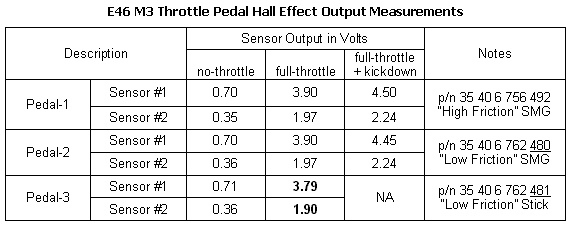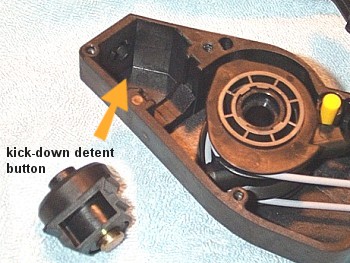An E46 M3 w/ SMG II "seems" to behave the same whether the throttle pedal is an SMG
version or a manual version (save the kick-down in the lower auto-modes being lost).
But is it "exactly" the same? Well, when measuring the output from the throttle pedal
which is sensed by the DME it turns out that the manual throttle pedal produces a reading
of 108% when fully depressed. However, the SMG throttle pedal, when fully depressed w/o engaging
the detent, produces a reading of 112%. These readings were obtained on BMW dealer diagnostic
equipment and are somewhat unclear as they are in essence an "interpretation" by the DME
of what is going on at the throttle pedal.
What is really needed is an exact measurement of the electrical output *at the throttle pedal*
for both no-throttle and full-throttle conditions. Exactly
such a measurement has been performed on three throttle pedal assemblies from the E46 M3. The results are
summarized in the following table:
|

|
The general result from these direct measurements is, again, that the throttle pedal from the E46 M3
with stick shift produces a lower *full-throttle* electrical output than the throttle pedal from an E46 M3 with SMG.
Granted, three assemblies is not a large data set to draw a conclusion from, but the very high
correlation in the measured values from the two SMG pedals sets the values from the stick pedal
in stark contrast. The full-throttle Hall sensor outputs for the stick shift pedal assembly are
2.8% and 3.6% lower than for the SMG pedal (for high and low outputs respectively).
These differences are comparable in magnitude to those obtained with the BMW diagnostic equipment.
So what does all this mean?
Well, without knowing how the DME software interprets the input commands from the throttle
pedal it is difficult to know for sure. For example, if the SMG version of
engine management software "expects" a value of 112% before it recognizes
a full throttle command, then with the manual pedal installed in an SMG M3 one would never be able to command
full throttle. Even with the manual pedal pushed fully to the floor, the DME would only
register 96.4% of full throttle. That last 3.6% would not be commandable. It is also possible,
though unlikely, that the SMG II software actually requires an input of 133% (i.e. with the detent
engaged) before recognizing a full throttle command. If this were the case
then installing the manual pedal in an SMG M3 would only allow one to command
81.2% max throttle, even with the manual pedal fully depressed. The reason that this case is considered
unlikely, however, is that no difference in engine load is perceivable by
most all M3 drivers when pushing an SMG throttle pedal past the detent. But the possibility
is stated here for completeness.
|
A third possibility
is that the DME software actually has a lower threshold for what it considers a "full-throttle"
command, and that say, any pedal input above 100% is interpreted as full-throttle. If this is
the case then it makes no difference to max. engine power whether an E46 M3 w/ SMG has a proper
SMG pedal assembly, or a pedal assembly from an E46 M3 with stick shift.
Some members of the Roadfly Message Board came up with a very creative field test which could
possibly be
used to show that the E46 M3 with SMG, and with a stick shift pedal assembly, still produces
maximum engine output at full throttle. The "Sport-Mode" test seems like a very good idea, but
there is one possible sticking point, and this is discussed on a
separate page
»
|
 Conclusion:
For those E46 M3 drivers who dislike the kick-down detent in their SMG II throttle pedals, what are the options?
One solution is to install a throttle pedal from an E46 M3 with stick shift. This pedal does not have
the annoying detent, and as shown (hopefully) in this article, it seems to work just fine and it
is not possible to prove that there would be any negative ramifications from doing this.
In fact this writer has adopted this particular approach and is quite satisfied with the resulting performance.
One could also leave the SMG pedal in the car, but fabricate some type of "pedal stop" that prevented
the throttle pedal from moving far enough to engage the kickdown detent. There are several ways that
this could be done, it would not be so difficult.
Alternatively, the actual mechanical detent button can simply be removed from the pedal assembly.
Removing the detent button altogether causes absolutely no loss in functionality, and still allows the pedal to move all
the way to the 133% position when fully depressed. So the kickdown software can work as it was designed to.
It's just that there is no longer
any resistance to pushing past the detent at the end of travel since the mechanism
that caused this resistance is no longer present.
Conclusion:
For those E46 M3 drivers who dislike the kick-down detent in their SMG II throttle pedals, what are the options?
One solution is to install a throttle pedal from an E46 M3 with stick shift. This pedal does not have
the annoying detent, and as shown (hopefully) in this article, it seems to work just fine and it
is not possible to prove that there would be any negative ramifications from doing this.
In fact this writer has adopted this particular approach and is quite satisfied with the resulting performance.
One could also leave the SMG pedal in the car, but fabricate some type of "pedal stop" that prevented
the throttle pedal from moving far enough to engage the kickdown detent. There are several ways that
this could be done, it would not be so difficult.
Alternatively, the actual mechanical detent button can simply be removed from the pedal assembly.
Removing the detent button altogether causes absolutely no loss in functionality, and still allows the pedal to move all
the way to the 133% position when fully depressed. So the kickdown software can work as it was designed to.
It's just that there is no longer
any resistance to pushing past the detent at the end of travel since the mechanism
that caused this resistance is no longer present.
|
 As shown in these last two photos the
mechanical detent button just slides right out of the SMG pedal assembly. It is apparent
that this button is in no way tied to the electrical output to the DME.
As shown in these last two photos the
mechanical detent button just slides right out of the SMG pedal assembly. It is apparent
that this button is in no way tied to the electrical output to the DME.
Ed Note:
It has been pointed out by one astute reader (Peter Glaskowsky
ideaphile.com/bmw/
)
that there is a possible negative
implication of removing the detent button from the SMG throttle pedal assembly.
Namely, one has now possibly created a "dead-zone" at full throttle where a small change
in the position of the pedal causes no change in commanded engine load to the DME. This might make it
difficult to modulate the throttle near the full travel range. From zero throttle all the
way to just before the detent engagement, the DME registers a gradual increase in input all
the way to 112%. At that point the DME considers that the driver is commanding
full throttle (this is speculation remember, but based on experience).
Any further travel in the pedal does not seem to be interpreted by the DME other than
it signals the SMG module to downshift.
So with the detent button removed the throttle pedal is now freely moving through the last
portion of its range but with no effect on engine load (when in S mode).
Perhaps a hard stop to replace the detent button is a better solution. This will be
highly user dependent and might take some trial and error to resolve.
|

 Conclusion:
For those E46 M3 drivers who dislike the kick-down detent in their SMG II throttle pedals, what are the options?
One solution is to install a throttle pedal from an E46 M3 with stick shift. This pedal does not have
the annoying detent, and as shown (hopefully) in this article, it seems to work just fine and it
is not possible to prove that there would be any negative ramifications from doing this.
In fact this writer has adopted this particular approach and is quite satisfied with the resulting performance.
One could also leave the SMG pedal in the car, but fabricate some type of "pedal stop" that prevented
the throttle pedal from moving far enough to engage the kickdown detent. There are several ways that
this could be done, it would not be so difficult.
Alternatively, the actual mechanical detent button can simply be removed from the pedal assembly.
Removing the detent button altogether causes absolutely no loss in functionality, and still allows the pedal to move all
the way to the 133% position when fully depressed. So the kickdown software can work as it was designed to.
It's just that there is no longer
any resistance to pushing past the detent at the end of travel since the mechanism
that caused this resistance is no longer present.
Conclusion:
For those E46 M3 drivers who dislike the kick-down detent in their SMG II throttle pedals, what are the options?
One solution is to install a throttle pedal from an E46 M3 with stick shift. This pedal does not have
the annoying detent, and as shown (hopefully) in this article, it seems to work just fine and it
is not possible to prove that there would be any negative ramifications from doing this.
In fact this writer has adopted this particular approach and is quite satisfied with the resulting performance.
One could also leave the SMG pedal in the car, but fabricate some type of "pedal stop" that prevented
the throttle pedal from moving far enough to engage the kickdown detent. There are several ways that
this could be done, it would not be so difficult.
Alternatively, the actual mechanical detent button can simply be removed from the pedal assembly.
Removing the detent button altogether causes absolutely no loss in functionality, and still allows the pedal to move all
the way to the 133% position when fully depressed. So the kickdown software can work as it was designed to.
It's just that there is no longer
any resistance to pushing past the detent at the end of travel since the mechanism
that caused this resistance is no longer present.
 As shown in these last two photos the
mechanical detent button just slides right out of the SMG pedal assembly. It is apparent
that this button is in no way tied to the electrical output to the DME.
As shown in these last two photos the
mechanical detent button just slides right out of the SMG pedal assembly. It is apparent
that this button is in no way tied to the electrical output to the DME.